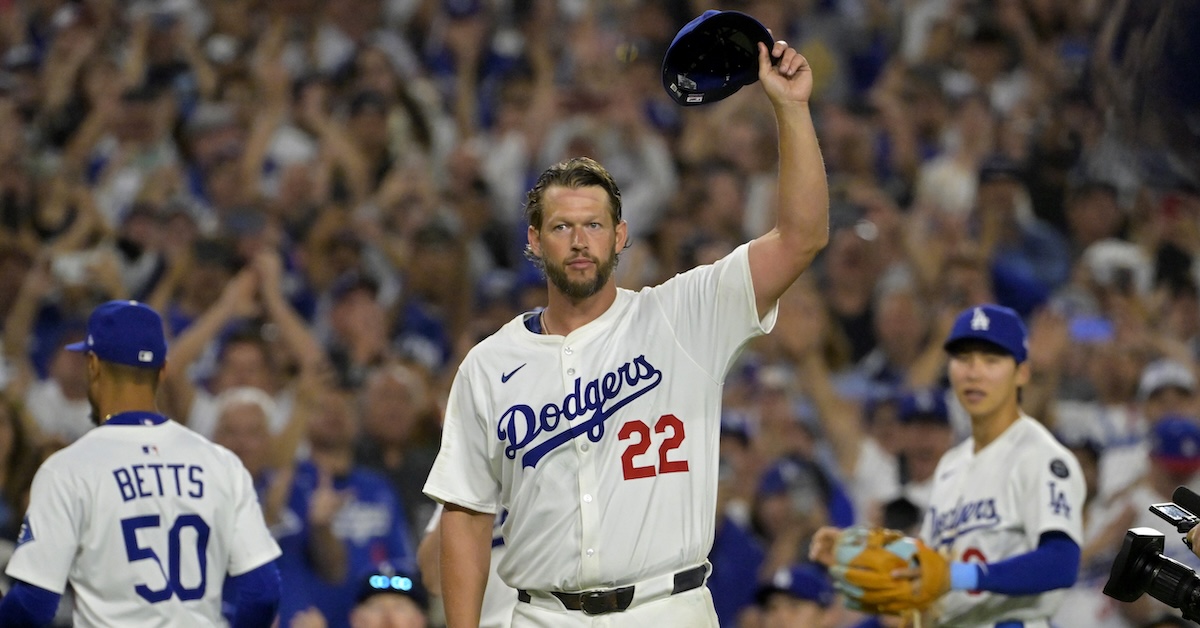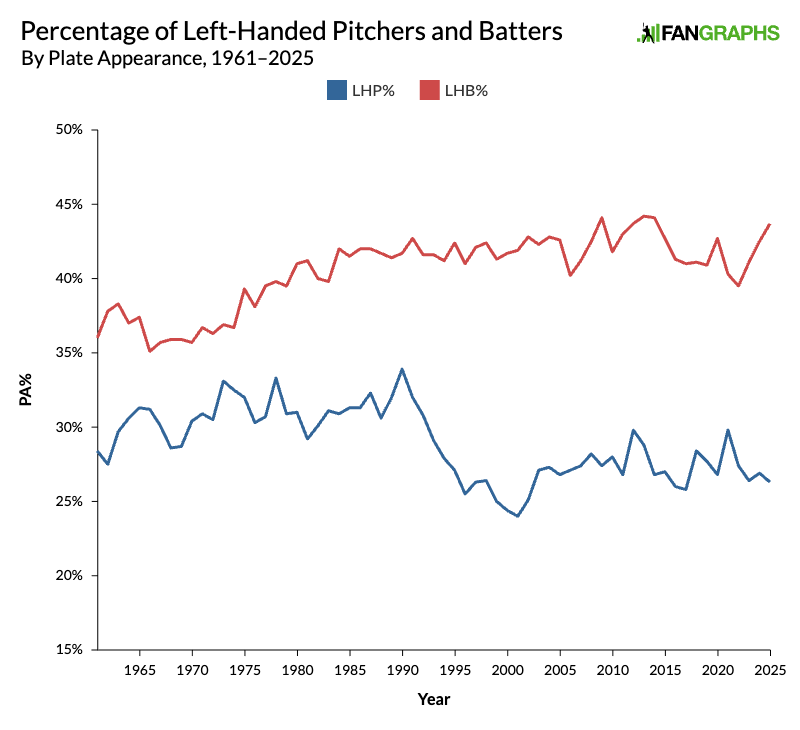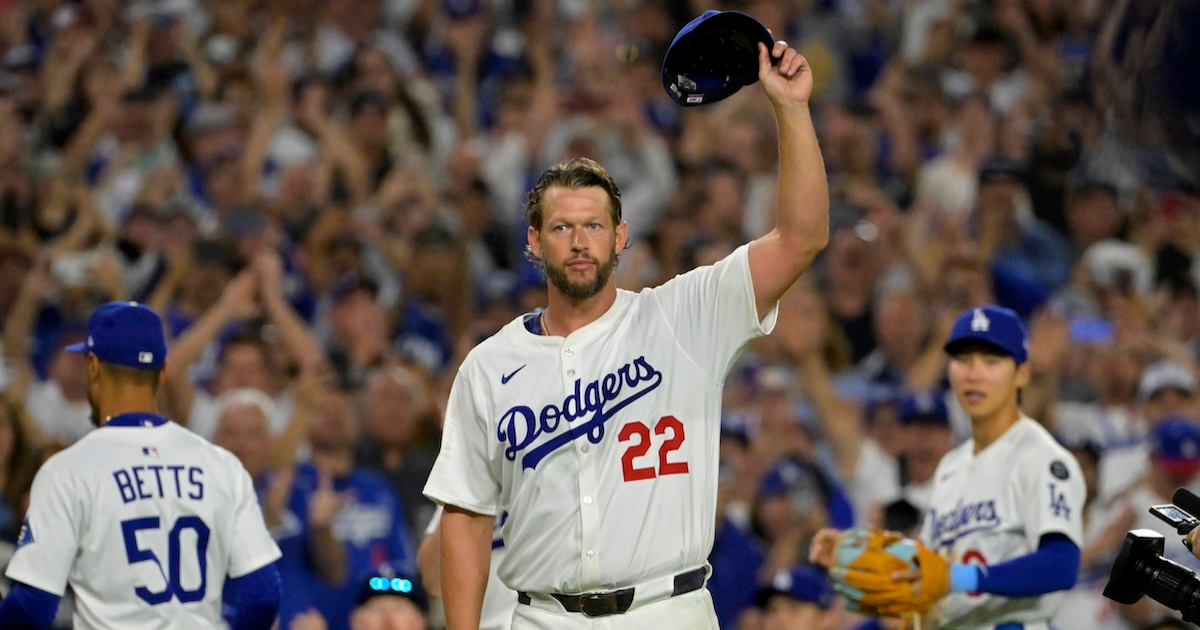
It was ugly, it was labor-intensive, it was sobering — and probably humbling. Clayton Kershaw entered Wednesday night’s start in Los Angeles needing just three strikeouts to reach 3,000 for his career. Facing the White Sox, a team with the American League’s worst record (28-57) and the majors’ second-highest strikeout rate against lefties (26.6%), the 37-year-old southpaw repeatedly struggled to get from strike two to strike three, and only reached the milestone on his 100th and final pitch of the night. By the time he caught Vinny Capra looking at a slider on the outside edge of the plate, the Dodgers trailed 4-2, and Max Muncy had just departed with a serious knee injury while applying the tag on an attempted steal of third base. It took a textbook ninth-inning rally for the Dodgers to salvage a victory.
Here’s the big moment:
Kershaw is the 20th pitcher to reach 3,000 strikeouts. Reflecting the long-term trend of increased strikeout rates, he’s the 19th to reach 3,000 in the past 51 years and the 10th to do so during the Wild Card era. He joins Max Scherzer (who notched his 3,000th strikeout on September 12, 2021 during his brief stint with the Dodgers) and Justin Verlander (who reached the mark on September 28, 2019) among the active hurlers in the club. He’s the fifth pitcher to record 3,000 strikeouts with a single team, after Walter Johnson, Bob Gibson, Steve Carlton, and John Smoltz; neither Johnson (Senators) nor Gibson (Cardinals) ever pitched for another team, while Carlton (Phillies) was on his second stop and Smoltz (Braves) on his first of three:
The 3,000 Strikeout Club, with Adjusted Rates
Pitcher Seasons SO IP Date K% K%+ ERA- FIP- Nolan Ryan 1966, ’68–93 5714 5386.0 7/4/1980 25.3% 183 90 83 Randy Johnson 1988–2009 4875 4135.1 9/10/2000 28.6% 176 75 73 Roger Clemens 1984–2007 4672 4916.2 7/5/1998 23.1% 150 70 71 Steve Carlton 1965–1988 4136 5217.1 4/29/1981 19.1% 135 87 87 Bert Blyleven 1970–1992 3701 4970.0 8/1/1986 18.1% 133 85 82 Tom Seaver 1967–1986 3640 4782.2 4/18/1981 18.8% 133 79 85 Don Sutton 1966–1988 3574 5282.1 6/24/1983 16.5% 117 92 91 Gaylord Perry 1962–1983 3534 5350.1 10/1/1978 16.1% 115 85 85 Walter Johnson 1907–1927 3508 5914.2 7/22/1923 15.0% 152 68 76 Justin Verlander* 2005–2025 3471 3483.1 9/28/2019 24.4% 123 78 81 Max Scherzer* 2008–2025 3419 2891.0 9/12/2021 29.3% 141 76 77 Greg Maddux 1986–2008 3371 5008.1 7/26/2005 16.5% 100 76 78 Phil Niekro 1964–1987 3342 5404.1 7/4/1984 14.7% 105 86 95 Fergie Jenkins 1965–1983 3192 4500.2 5/25/1982 17.4% 125 87 88 Pedro Martinez 1992–2009 3154 2827.1 9/3/2007 27.7% 168 66 68 Bob Gibson 1959–1975 3117 3884.1 7/17/1974 19.4% 130 78 81 Curt Schilling 1988–2007 3116 3261.0 8/30/2006 23.5% 139 80 76 CC Sabathia 2001-2019 3093 3577.1 4/30/2019 20.6% 114 87 87 John Smoltz 1988–99, 2001–09 3084 3473.0 4/22/2008 21.6% 130 81 78 Clayton Kershaw* 2008–2025 3000 2787.1 7/2/2025 27.3% 132 64 70
Date = date of 3,000th strikeout. K%+ = league-adjusted strikeout rate, based on strikeouts per plate appearance for all pitchers except Walter Johnson, whose rate is based on strikeouts per nine innings. * = active.
Note that Kershaw owns not only the lowest ERA- of any pitcher in the club but the lowest of any with at least 2,000 innings. Remarkably, he’s just the fourth lefty to reach 3,000 strikeouts, after Carlton, Randy Johnson, and Sabathia. I dug into that particular oddity on the occasion of Sabathia’s milestone in 2019. It’s founded in the relative scarcity of lefty pitchers, at least in terms of batters faced:

Though Kershaw entered the night on something of a roll, having gone 4-0 with a 1.57 ERA and 21 strikeouts in 23 innings over his his last four starts, nothing came easily for him on Wednesday night. Though he went to two strikes on each of the first four hitters he faced, five of the first six, and eight of the first 11, he couldn’t put any of them away. He was touched up for a first-inning run when Andy Pages misplayed an Austin Slater drive into a triple and then Andrew Benintendi roped a single to right. Kershaw needed Michael Conforto to rob Lenyn Sosa of an extra-base hit with a leaping catch near the top of the left field wall to end the first without further damage, that after throwing 29 pitches — though he did get five swinging strikes.
Kershaw was much more efficient in a clean, 10-pitch second inning, but didn’t draw any closer to 3,000. He finally got his first strikeout in the third inning, whiffing former teammate Miguel Vargas on a 12-to-6 curve on the outside corner — his 14th two-strike pitch of the night — but only after serving up a two-run homer to Slater to fall behind 3-2. A Benintendi double and an Edgar Quero single put the White Sox up 4-2, and suddenly it looked like Kershaw might not even make it through three innings, let alone get three strikeouts. He settled down, but didn’t record his second strikeout until Sosa chased a curveball in the dirt on Kershaw’s 92nd pitch, his final one of the fifth inning:
That pitch count matched Kershaw’s season high; he hadn’t thrown more since June 20, 2023. Even so, manager Dave Roberts — who said beforehand that he would manage this game differently given the circumstances — sent him out for the sixth. He needed just three pitches to retire lefty Mike Tauchman, covering first base himself on a grounder to Freddie Freeman, but Michael A. Taylor followed that by ripping a 99.9-mph double down the left field line. Roberts remained on the top step of the dugout. On Kershaw’s next pitch, a 91-mph fastball to Capra, Taylor took off for third. Catcher Will Smith made a perfect peg, and Muncy dropped the tag on him, albeit while moving into the runner’s path; Taylor upended the third baseman in the process, and Muncy came down clutching his left knee in agony. He had to be helped from the field. Kershaw kept his distance as the Dodgers tended to Muncy, throwing a warmup pitch or two while Enrique Hernández loosened up to take over in the field.
Kershaw went back to work, throwing a curveball in the dirt, getting Capra to chase a low slider, and finally freezing him with another slider closer to the outside edge of the zone. He was characteristically reserved after the pitch, no leaps or fist-pumps, just a slow walk off the mound before tipping his cap and finally basking in the adulation of the 53,536 fans at Dodger Stadium, including his wife and growing family. After a round of hugs in the dugout, he returned for a curtain call.
In all, Kershaw went to two strikes on 16 of the 27 batters he faced, and threw 26 two-strike pitches, only two of which became swinging strikes; three became hits, including the two extra-base knocks by Slater. He did get a season-high 15 whiffs, nine on the slider, three on the curve, two on the fastball and one on the splitter that he’s begun dabbling with in recent years. He was on the hook for a loss until the bottom of the ninth, when the Dodgers finally broke through against relievers Grant Taylor and Steven Wilson. A Conforto single, and walks by Tommy Edman and Hyeseong Kim loaded the bases with nobody out, then Shohei Ohtani beat out a double-play grounder, Mookie Betts hit a sacrifice fly, Ohtani stole second, Smith walked, and Freeman smacked a sharp single to right to bring home Othani:
“I made it take too long,” said Kershaw of reaching 3,000. “Honestly, didn’t pitch that great tonight, and the slider was so bad. But this was such a special night all the way around. It really was. Couldn’t have asked for anything more, really. It was so fun to get to be out there.”
This is quite probably the last major milestone in a career that will carry Kershaw to Cooperstown. He won his 200th game on April 18, 2023, but has only increased his total to 216 since, and reaching 250 à la Sabathia and Verlander is almost certainly out of the question. Even getting to 233 wins — which would match Sutton for the most as a Dodger — seems highly unlikely. Kershaw is on the cusp of moving into the top 20 in S-JAWS, 0.1 point behind Robin Roberts, but nobody is going to stop play when that happens or to acknowledge if he gets to 80 WAR (he’s at 79.6 bWAR and 77.0 fWAR). At this point, he’s no threat to add to his totals of 10 All-Star appearances, five ERA titles, and three Cy Young Awards, particularly given that he hasn’t thrown the 162 innings necessary to qualify for the ERA lead since 2019.
Per the Elias Sports Bureau, Kershaw is the fourth-fastest pitcher to 3,000 strikeouts in terms of innings:
Fastest to 3,000 Strikeouts
Pitcher Innings Randy Johnson 2,470.2 Max Scherzer 2,516.0 Pedro Martinez 2,647.2 Clayton Kershaw 2,787.1 Nolan Ryan 2,802.0
SOURCE: Elias Sports Bureau
For as quickly as he reached 3,000 in comparative terms, the pursuit of the milestone became a slog due to Kershaw’s injures (to say nothing of the way he’s recently tested fans’ patience). He finished the 2021 season, his age-33 campaign, needing just 330 strikeouts to reach the milestone; based on his 2019–21 performances, that looked doable across a pair of 25-start seasons. While he continued to pitch effectively, making All-Star teams in both 2022 and ’23, with ERAs of 2.28 and 2.46 (but FIPs of 2.57 and 4.03, respectively), he totaled just 46 starts and 274 strikeouts in that span, leaving him 56 strikeouts shy of the magic mark.
The real turning point came at the end of June 2023, by which point Kershaw had run his strikeout total to 2,912. He landed on the injured list with left shoulder soreness and missed six weeks, and his fastball — indeed, his stuff — hasn’t been the same since. He threw just 36.1 innings in eight post-injury starts in 2023, with his monthly average four-seam velocity losing 2.7 mph from June (91.3 mph) to September (88.6). The pitch modeling metrics paint a stark picture before and after the injury:
Clayton Kershaw via PitchingBot and Stuff+
PitchingBot IP bot Stf FA botStf SL botStf Cu botStf botCmd botOvr 2022 126.1 53 50 52 51 62 57 2023 Pre-Injury 95.0 50 45 52 47 56 53 2023 Post-Injury 36.1 45 33 49 37 44 35 2024 30.0 44 31 48 37 54 43 2025 44.2 46 32 48 36 50 40 2022 126.1 101 119 122 112 101 113 2023 Pre-Injury 95.0 98 120 126 113 98 110 2023 Post-Injury 36.1 85 104 111 98 85 86 2024 30.0 90 106 117 101 96 100 2025 44.2 89 94 107 94 96 94
Stuff+ is on a scale where 100 is average; PitchingBot on the 20-80 scouting scale, where 50 is average.
The Dodgers were vague about the condition of Kershaw’s shoulder. “He’s going to keep going until he can’t,” said Roberts after a rough September 5, 2023 start. “I think the hope is he’s going to continue to feel better, but given where he’s at physically, it’s hard to say that’s going to happen.”
Kershaw finished the 2023 regular season with 2,944 strikeouts, then endured the most humiliating start of his career, retiring just one of the eight Diamondbacks he faced while being charged with six runs in the Division Series opener, a loss that prefigured the 100-win squad getting swept, and for a time looked as though it might have been Kershaw’s last appearance in Dodger blue. In early November, he announced that he had undergone surgery to repair the glenohumeral ligaments and capsule of his left shoulder, and hoped he would be able to return to play “at some point next summer,” but even that winter, he continued his annual flirtation with the possibility of joining the Rangers to pitch closer to home.
Kershaw returned to the fold and made his 2024 debut on June 25, but he cracked the five-inning mark in just three of seven starts, and pitched to a 4.50 ERA — over two runs higher than his career mark to that point — and 3.53 FIP. One batter into the second inning of his August 30 start against the Diamondbacks, he departed due to pain in his left big toe, and was subsequently diagnosed with a bone spur. He continued his throwing program, with the team readjusting his spikes to help compensate for his soreness, but compromised mechanics triggered pain in other parts of his body, no small matter given his shoulder surgery and his previous back problems.
Kershaw ended the regular season still 32 strikeout short of 3,000, and on October 5, the team announced that he would be shut down regardless of how far the Dodgers advanced in the playoffs, a decision that, in conjunction with other injuries (most notably Tyler Glasnow’s elbow sprain), led to the Dodgers relying upon a three-man rotation plus occasional openers during their championship run. Kershaw was a bystander. “I didn’t have anything to do with this championship, but it feels like I have the best feeling in the world — that I get to celebrate with you guys!” he said at the team’s celebratory parade while also proclaiming himself a “Dodger for life.”
Shortly after the World Series, orthopedic surgeons played a doubleheader on Kershaw’s left leg. One surgery repaired the torn meniscus in his left knee, an injury that went undiscovered until he went through testing regarding his foot, while the other dealt with the bone spur in his left foot as well as arthritis and a ruptured plantar plate, the ligament that runs beneath the metatarsal heads and keeps the toes aligned.
As with the previous winter, Kershaw and the Dodgers didn’t formalize a contract until February so as to allow the team to put the spot on the 40-man roster to better use. When he finally returned to the majors on May 17, he was lit for five runs in four innings by the Angels. Rain curtailed his next start after two shutout innings against the Mets in New York, but since then, he’s used smoke and mirrors in impressive fashion. Prior to Wednesday, he’d lasted at least five innings in five out of his last six starts, allowing two runs or fewer in each of those, with a five-run, 4.2-inning turn against the Mets on June 3 the exception. While he’s carrying a respectable 3.43 ERA, he’s struck out just 17.5% of hitters and has an 8.8% strikeout-to-walk differential; both are career lows, while his 7.7% walk rate is his highest since 2010. His 4.34 FIP and 105 FIP- are both career worsts.
Even in diminished form, the innings have been valuable to the Dodgers, coming at a time when their rotation has been hit hard by injuries. Blake Snell made just two starts, and Glasnow five, before landing on the injured list with shoulder inflammation. Both are currently on rehab assignments, but Roki Sasaki, who went down in mid-May after eight starts due to a shoulder impingement, only recently resumed his throwing program, and Tony Gonsolin, who made seven starts after returning from late-2023 Tommy John surgery and a spring back injury, is now on the 60-day IL due to elbow soreness. Ohtani has finally begun pitching in games following his late-2023 UCL reconstruction, but he has totaled just four innings over three opener-style starts.
Four years ago, as Scherzer approached 3,000 strikeouts, I had Dan Szymborski run a ZiPS projection showing the odds of other active pitchers reaching the milestone. Scherzer (98%) and Kershaw (91%) made good, but Zack Greinke (88%) pulled up 21 strikeouts short, never announcing his retirement but simply not signing another contract after 2023. At the time, Gerrit Cole (66%) and Jacob deGrom (51%) appeared more likely than not to reach 3,000, but both have undergone Tommy John surgery since, and the latter has fallen below 10%. Here’s the updated board:
Sale has pitched his way out of the wilderness to boost his odds from 49% circa 2021, though he’s currently sidelined by broken ribs. Forty-one-year-old Charlie Morton and 38-year-old Yu Darvish are the only other pitchers besides Kershaw, Sale, and Cole who even have 2,000 strikeouts, but they’re not going to get to 3,000. For everybody else, it’s mainly about crossing fingers and hoping they remain healthy and effective — a prayer for the wing, so to speak — for many, many more years.
All of which is to say that it could be a long while before we see another pitcher do what Kershaw just did. We already knew that, but even in his diminished form, his accomplishment on Wednesday night is one to savor.
